Research on the spot. Perfect pitch. Conversation flows smoothly. Everything seems to be going your way. Until the prospect leans back and says:
“It’s too expensive.”
“We’re not ready right now.”
“We already work with someone.”
And your confidence drops from sky-high to rock bottom in no time. Every B2B sales rep has faced that sinking feeling of losing a promising sale yet again.
But don’t let your confidence drop. It’s an important part of the sales process. Objections are not rejection of you.
Research states that 92% of salespeople give up after four “no’s,” but 80% of prospects say “no” four times before they say “yes.”
Buyers are often clouded by uncertainty, pressure, and fear. The only way to address these insecurities is by learning how to handle sales objections and guiding the buyer with empathy and clarity.
What Are the 5 Types of Sales Objections?
Table of Contents
Here are the top 5 common sales objection handling examples and how to handle them:
1. “It’s too expensive.”
It is easy to assume that when a prospect tells you something is too expensive, they are referring to the price tag. But in reality, they are wrestling with the question: “Is this worth it?”
Most decision-makers are working with tight budgets, increased scrutiny, and a fear of wasted investment. The natural response of many sales reps is to slash prices or oversell. But doing this makes sales reps seem transactional and adds pressure instead of reassurance.
So, what works?
It is better to pause, acknowledge their concern, and walk them through how the cost aligns with the value. A stronger approach is to anchor the discussion around the outcomes.
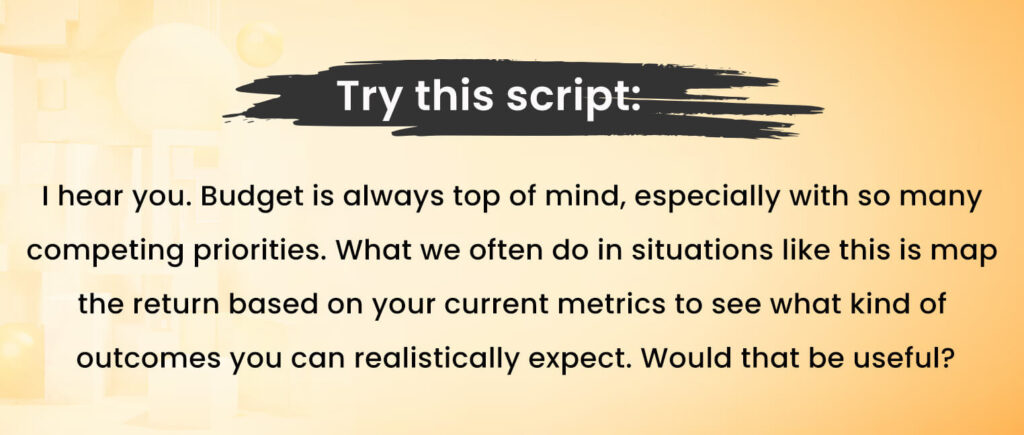
By anchoring the conversation in impact rather than features, you help the buyer feel confident that they are not spending more; they are gaining more. This shifts the conversation from cost to value.
2. “We don’t need this right now.”
Yes, this objection can be discouraging, especially when you have done your homework and know your solution fits their profile.
But beneath that objection, there is often something deeper. Your solution simply might not be tied to an urgent problem in their minds yet.
Maybe they are overwhelmed with current initiatives. Maybe they do not see the pain you are trying to solve. Either way, their response is valid.
So instead of trying to prove them wrong, invite a deeper conversation.
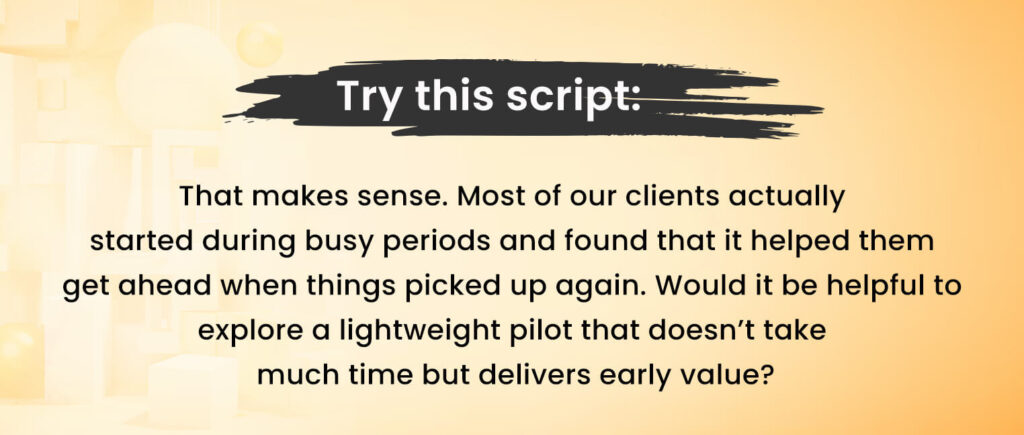
This is how you reframe your conversation. You are not trying to push your agenda. You are aligning with theirs. In talking through their workload or bottlenecks, they may discover the very need you are helping solve.
3. “I need to check with my team.”
This is a tricky one. Your contact seems interested, maybe even excited, but they are hesitant to move forward without others in the loop.
It is easy to feel like the momentum is slipping, but this is not a shutdown. In fact, it’s a good sign that they care about making the right call and want internal buy-in.
So instead of stepping back and waiting, offer support. Make it easier for them to be your internal advocates.
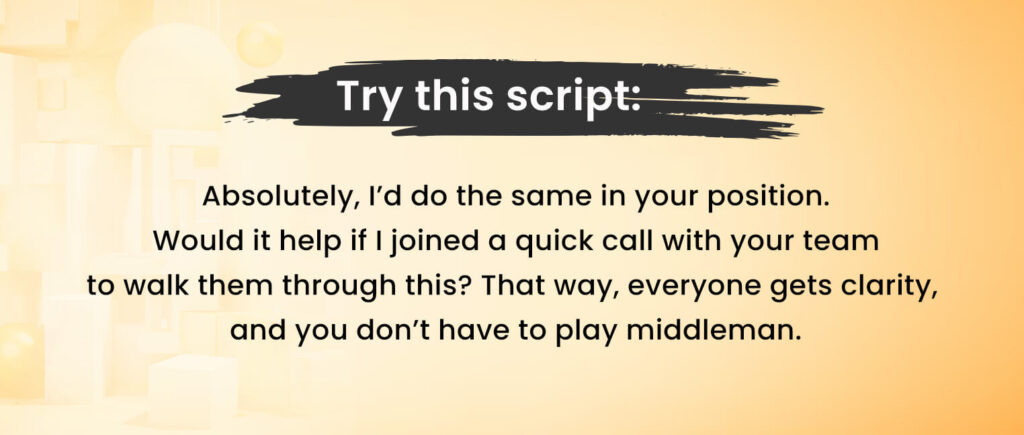
This simple gesture shows respect for their process while helping you stay involved. It also reduces the chance of miscommunication or delays.
Remember, you are not just selling to one person. You are building alignment across stakeholders.
4. “Now’s not the right time.”
Sometimes, timing objections are not about your product. They are about mental bandwidth. The prospect may believe in your solution, but they simply cannot take on one more thing.
This is where patience and flexibility matter.
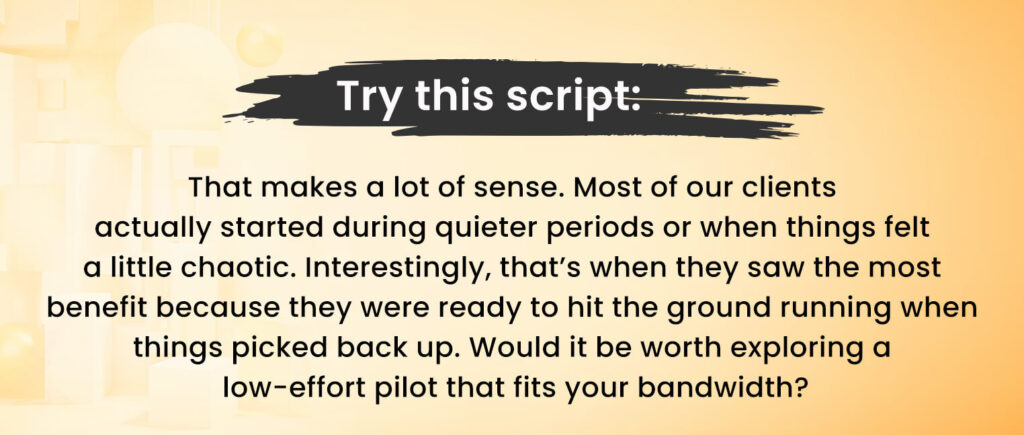
By doing this, you are not pushing them. You are easing their worry. You are offering a path that fits their reality, not your sales calendar. This is how you build trust and show that you are genuinely on their side.
5. “We already work with someone.”
This one can sting a little. You feel late to the party. But if we are being honest, most companies already have something in place. That does not mean they are thrilled with it.
“We are working with someone else” can feel like a dead end. But it is actually an invitation to explore where things could be better.
So, rather than challenging their current provider, encourage reflection.
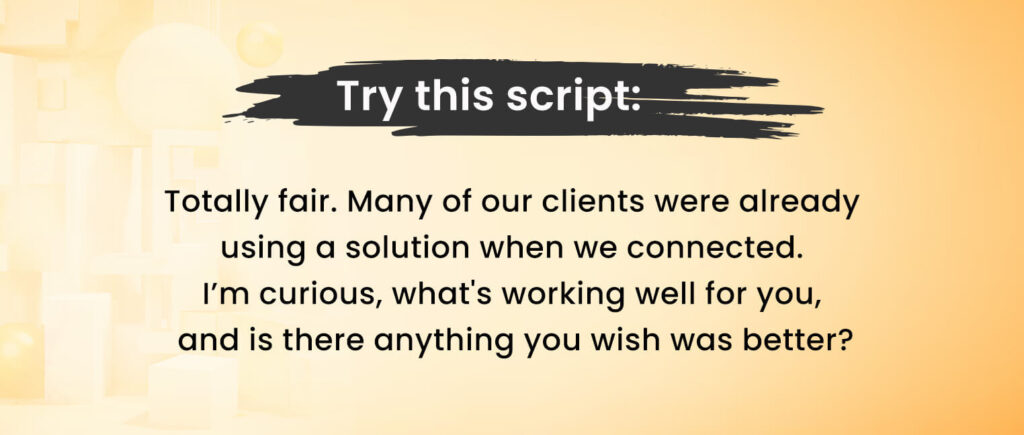
This opens the door for an honest conversation. If there are gaps, you will learn where you might fit in. Even if the timing is not right, you will leave a positive impression by being respectful and not comparative.
How to Build a Sales Team That Handles Objections Like Pros
Every sales leader knows the feeling when something just goes off.
Maybe they rushed to answer. Maybe they got defensive. Maybe they just didn’t know what to say.
It’s not that they didn’t care. It’s that they weren’t prepared. This is where cracks show.
Too often, sales teams are inconsistent in handling objections. One rep might navigate pricing conversations with finesse, while another stumbles when asked about ROI. This results in mixed messaging, lost trust, and deals that stall or disappear entirely.
This shouldn’t be the case. Most successful teams aren’t natural-born closers. They’re built through deliberate coaching, shared frameworks, and real-time support.
Start with Frameworks That Work
Give your reps a foundation to lean on. A proven structure like LAER (Listen, Acknowledge, Explore, Respond) or ARPA (Acknowledge, Respond, Pivot, Ask) could help in turning awkward conversations into consultative ones.
Such a framework offers reps clarity in the moment and gives them permission to slow down, understand, and respond with purpose without panic.
Practice Makes Progress
Is objection handling something you master on calls alone? Not really.
You need to build a rhythm of weekly role-play sessions, wherein your team rehearses real-world objections they have encountered.
Let them test language, tone, and timing. Create a space where it is okay to fumble. Because it is better to fumble in practice than in front of a prospect.
Build an Objection-Response Library
Note what works. Document responses that worked best for common objections. Ensure they are easily accessible. Ideally, it should be inside your CRM or sales playbook template.
So, whether it is price hesitations, competitor comparisons, or timing delays, your team should never have to start from scratch.
Leverage Real-Time Coaching
You can use call recordings or AI-powered tools to review how objections are being handled on live calls. Offer constructive feedback on what went well, what could be improved, and how different phrasing might change the tone of the conversation. These micro-adjustments can lead to massive improvements in win rates.
Objections Are Just Opportunities in Disguise
Objections are not stop signs. They are signals. Signals that your buyer is engaged, thinking critically, and trying to make the best decision for their business.
Handled with empathy and clarity, objections give you the chance to:
- Re-establish value
- Align on what truly matters
- Show up as a partner, not just a seller
But to do this consistently, your sales team needs more than clever comebacks. They need a shared language, a system, and a leader who believes that confidence is built through preparation, not pressure.
And once that foundation is in place, the “we are not sure” moments do not feel like deal-breakers anymore. They feel like turning points.

Vikas Bhatt is the Co-Founder of ONLY B2B, a premium B2B lead generation company that specializes in helping businesses achieve their growth objectives through targeted marketing & sales campaigns. With 10+ years of experience in the industry, Vikas has a deep understanding of the challenges faced by businesses today and has developed a unique approach to lead generation that has helped clients across a range of industries around the globe. As a thought leader in the B2B marketing community, ONLY B2B specializes in demand generation, content syndication, database services and more.





